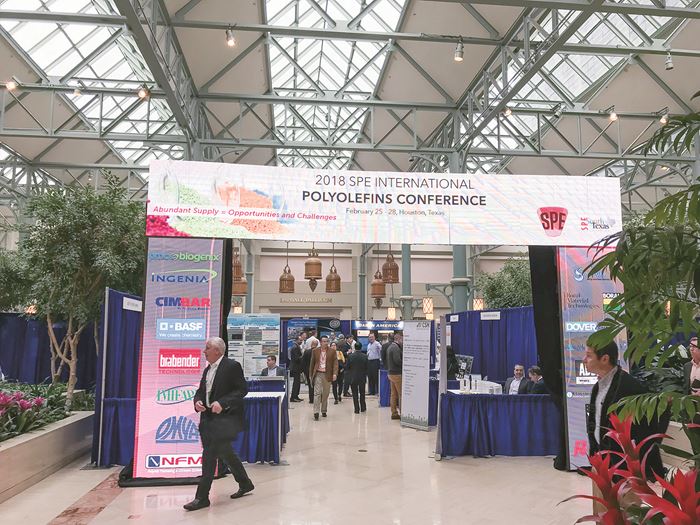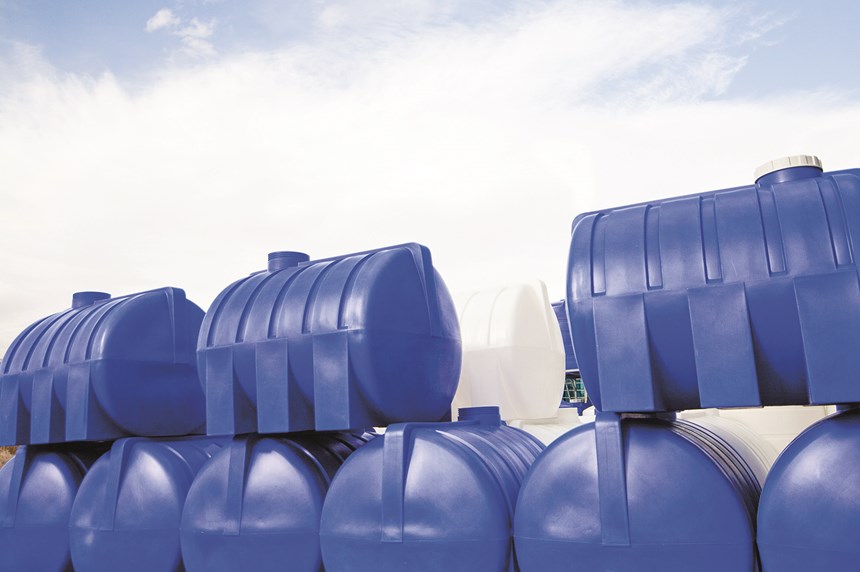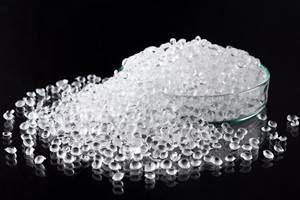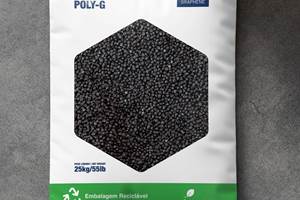Materials Innovations for Film, Molding & Automotive
Highlights of the SPE Polyolefins Conference included a ‘game-changing’ LLDPE family, and new stabilizers and other additives for film extrusion and all types of molding.
A variety of new developments in materials, additives, and processing were dominant themes at SPE’s International Polyolefins 2018 conference, held in Houston in late February. There were over 700 attendees at what’s said to be the world’s largest polymer conference dedicated to polyolefins. There were 67 technical papers, five keynote plenary talks that addressed major industry trends, and 64 exhibitors.
Among the highlights is a unique family of LLDPE that can rival mLLDPE in flexible films, three new polyolefin stabilization systems, a new halogen-free flame retardant for a range of polyolefin formulations, advances in clarifying blow molded bottles, and new mineral fillers for demanding automotive TPO components.
‘GAME-CHANGING’ LLDPE FOR FILM
Austria’s Borealis Group (U.S. office in Port Murray, N.J.) unveiled a new family of high-performance LLDPE resins that offer performance similar to metallocene LLDPE (mLLDPE) in the flexible film arena—but with some advantages. Produced with the company’s proprietary Borstar bimodal technology—two-reactor systems using two comonomers and a new “smart” catalyst—the new Anteo family is a new generation of high-purity and transparent Borstar Bimodal Terpolymers (BBT). Until now, Borstar technology did not deliver highly transparent sealing materials, according to Maurits van Tol, senior v.p. of innovation & technology.
Tested and confirmed by more than 100 customers, the overall performance of Anteo is said to exceed that of existing mLLDPE sealants, making Anteo a better option for a sealing material and for other flexible films where a boost in mechanical performance is needed. Anteo’s attributes are said to include:
- Easy processability at lower extruder pressure—over 15% less than with conventional mLLDPE sealants.
- Improved sealing integrity and sealing speeds when used in laminated/non-laminated film, resulting in lower energy consumption and less material waste.
- Wider sealing window, lower seal-initiation temperature, and better hot-tack performance.
- Strong optics for enhanced shelf appeal.
- A step change in puncture resistance.
The Anteo family reportedly opens a range of opportunities in packaging—including frozen foods, pet foods, detergents, and personal-care products. Applications include laminates, stand-up pouches, heavy-duty shipping sacks, and stretch hoods.
Tested and confirmed by over 100 customers, Borealis’s new Anteo LLDPE offers wide-ranging benefits for packaging films.
NEW STABILIZATION SYSTEMS
A newly patented family of blended antioxidant products with a new mode of pH-control technology for PP was discussed by Addivant, Danbury, Conn. Warren Ebenezer, research manager for polymer applications, said the company now has powder-free NDB (No Dust Blend) additive packages with and without calcium stearate. All have full FDA compliance and are said to provide processors with unparalleled control over color and melt-flow rate. “Our new pH-control technology is being investigated throughout the polymer arena and is showing promise in many additional areas such as PE, engineering polymers and elastomers. We believe that this concept will reset the baseline performance demanded by polymer compounders.”
Dover Chemical, Dover, Ohio presented the latest findings on its new class of liquid polymeric phosphite antioxidants—used primarily as process stabilizers in polyolefins. A proprietary, high-molecular-weight liquid phosphite, Doverphos LGP-11, has been shown to be an excellent replacement for workhorse phosphite TNPP, particularly for polyolefin packaging, where purity is an issue. LGP-11 contains no alkyphenols, has low migration, and displays excellent color performance, compatibility, and hydrolytic stability, Dover says.
In addition to providing melt-process stability, initial color and color hold, reduction of gels during film processing, and maintenance of mechanical and physical properties during long-term heat aging, LGP-11’s unique chemistry and high MW are said to provide additional benefits during and after processing and post processing. These include excellent gas-fade performance during NOx exposure and heat aging, typically contributed by hindered phenolic antioxidants.
Dover researchers have found such color issues can be solved with blends of LGP-11 and Vitamin E—the latter replacing the hindered phenolic antioxidant at much lower levels in LLDPE. LGP-11 was shown to improve initial color, protecting the Vitamin E from over-oxidation and resulting in little color increase upon aging.
Gamma irradiation sterilization performance is also improved as has been shown in PP containers for medical devices, bottles and syringes. Because it does not contain alkylphenols, LGP-11 does not decompose as do other phosphites, and does not discolor under gamma-radiation sterilization.
Improvements in melt fracture reportedly are also achieved with LGP-11, which has been found to act synergistically with fluoropolymer-based process aids (PPAs). LGP-11 has been shown to reduce the time it takes the PPA to coat the die, allows the extruder to operate at higher speeds before producing melt fracture, and allows lower PPA use levels.
Songwon International Americas, Friendswood, Texas, reported on two developmental UV stabilizer systems specifically designed for rotomolding. Exp UV 0117 for water and chemical tanks and Exp UV 0217 for bulk containers are synergistic blends of HALS (hindered amine light stabilizer) and a UVA (UV absorber). They reportedly cover a broad range of UV requirements (UV-8 and UV-16 rating) and offer excellent performance in unpigmented LLDPE. Low color after rotomolding and low volatility, good extraction resistance, and contribution to long-term thermal stability are also claimed. The company aims to commercialize these new stabilizers by midyear.
Solvay Technology Solutions, formerly Cytec (U.S. office in Saddle Brook, N.J.), introduced a novel UV stabilizer system that boasts outstanding color stability, gloss retention, and low odor, with extremely low contribution of VOCs, and excellent performance in carbon-fiber-reinforced and long-glass-fiber reinforced polyolefins. It targets automotive interior and exterior applications.
OTHER NOVEL POLYOLEFIN ADDITIVES
A newly developed nitrogen-phosphorus flame retardant primarily for polyolefins was discussed by Japan’s Adeka, represented here by Amfine Chemical Corp., Hopkinsville, Ky. ADK Stab FP-2200S is a white powder with a thermal decomposition temperature above 500 F (260 C). It boasts low heat release and very low smoke release and smoke density, along with very low CO and CO2 emissions. There are no corrosive gases released, and it forms a homogeneous char layer with closed cell structure.
Recommended for PP, PE, EVA and other polyolefin compounds, it typically can be used at significantly lower loadings than ATH or MgH, as well as ammonium polyphosphates. It has been shown to result in reduced density of the final compound compared with inorganic and halogen-based flame-retardants.
Milliken Chemical, Spartanburg, S.C., presented its latest advance in clarified PP for blow molding. When the company launched its fourth-generation Millad NX8000E clarifier seven years ago for extrusion blow molding, it found that it could not replicate good results in industrial settings, according to Zach Adams, North American sales manager for plastics additives. He noted that the clarifier improved the appearance of blow molded bottles significantly compared with traditional clarification.
However, Milliken found only moderate improvements when running double-station, fast-output shuttle machines. While trials are ongoing, Adams discussed how Milliken has been able to overcome these limitations via the synergy between NX8000E clarifier and optimized rheology. In one study, optimizing rheology enables NX 8000E to perform under industrial settings at 376 F (191 C). In yet another case study, optimized rheology vs. standard architecture enabled the clarifier to offer superior visual appearance at a parison temperature of 417 F (214 C).
Adams noted that Milliken has conducted 13 different industrial trials in Europe, with the next one slated in North America. “We have been able to replicate see-through clarity and gloss,” adding that all trials used FDA-approved PP grades made with Z-N catalyst and there were no changes in processability of these resins.
Two new high-performance developmental mineral fillers for PP and TPO were discussed by Maz Bolourchi, senior manager for polymer applications at Imerys Performance Additives North America, San Jose, Calif. Both are targeted for automotive applications like under-hood components that require high reinforcement and good CLTE.
EXP-ND127 is a proprietary acicular (needle-shaped) fiber hybrid in the Wollastonite family. In TPO formulations, it enhances stiffness and flow as well as lightweighting. It is recommended for both interior and underhood components.
E7542 is a highly delaminated, high-aspect-ratio mica that provides maximum stiffness and CLTE in TPOs, suiting it to underhood components. “The higher the aspect ratio, the better the distribution,” noted Bolourchi. He added that both minerals fit in well with the trend in automotive TPO impact requirements for demanding applications to move from -22 to -40 F (-30 to -40 C).
Questions About Polyolefins? Visit the Polyolefins Zone.
Related Content
K 2022 Additives & Materials: Sustainability in the Lead
Nearly all of the new additives highlighted at the big show are aimed at enhancing recyclability of commodity resins and some volume engineering resins such as nylon and PC. A few new materials, on which we had not previously reported, also surfaced at K 2022.
Read MoreGerdau Graphene Launches “First” Graphene-Enhanced PE Additive Masterbatch for Extruded Packaging and More
The company has also partnered with conglomerate Sumitomo Corp. for distribution of its graphene-enhanced masterbatches in Japan.
Read MoreRiverdale Global Showing Latest Innovations and New Satellite Location in Wisconsin
NPE2024: Live demos of updated RGS controller are among the highlights at its Wisconsin facility that will house the ‘new’ color R&D lab.
Read MoreTosaf’s Investments in North America Result in 40% Increase in Production Capacity
Backed by a global presence, Tosaf provides localized additive and color solutions, and services for the plastic industry in North America.
Read MoreRead Next
For PLASTICS' CEO Seaholm, NPE to Shine Light on Sustainability Successes
With advocacy, communication and sustainability as three main pillars, Seaholm leads a trade association to NPE that ‘is more active today than we have ever been.’
Read MorePeople 4.0 – How to Get Buy-In from Your Staff for Industry 4.0 Systems
Implementing a production monitoring system as the foundation of a ‘smart factory’ is about integrating people with new technology as much as it is about integrating machines and computers. Here are tips from a company that has gone through the process.
Read MoreLead the Conversation, Change the Conversation
Coverage of single-use plastics can be both misleading and demoralizing. Here are 10 tips for changing the perception of the plastics industry at your company and in your community.
Read More

























